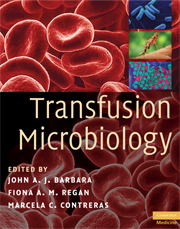Book contents
- Frontmatter
- Contents
- List of contributors
- Foreword
- Preface
- Acknowledgements
- Glossary
- Introduction: Transfusion-transmitted infections, then and now
- Section 1 Agents
- 1 Hepatitis viruses
- 2 Antibody to hepatitis B core antigen
- 3 Herpes viruses
- 4 Retroviruses
- 5 Parvovirus B19 (human erythroviruses)
- 6 Emerging viruses in transfusion
- 7 Bacterial contamination in blood and blood components
- 8 The protozoan parasites
- 9 Prion diseases
- Section 2 Selection and testing
- Section 3 Surveillance, risk and regulation
- Index
- Plate section
- References
8 - The protozoan parasites
from Section 1 - Agents
Published online by Cambridge University Press: 12 January 2010
- Frontmatter
- Contents
- List of contributors
- Foreword
- Preface
- Acknowledgements
- Glossary
- Introduction: Transfusion-transmitted infections, then and now
- Section 1 Agents
- 1 Hepatitis viruses
- 2 Antibody to hepatitis B core antigen
- 3 Herpes viruses
- 4 Retroviruses
- 5 Parvovirus B19 (human erythroviruses)
- 6 Emerging viruses in transfusion
- 7 Bacterial contamination in blood and blood components
- 8 The protozoan parasites
- 9 Prion diseases
- Section 2 Selection and testing
- Section 3 Surveillance, risk and regulation
- Index
- Plate section
- References
Summary
Transmission of infectious agents by blood transfusion has been an ongoing concern of transfusion medicine for decades. For years, the focus of concern has appropriately been on a variety of viral agents (e.g. HIV, hepatitis viruses, West Nile virus) that are known to pose blood safety risks. However, in recent years, infections resulting from protozoan parasites have received more prominent attention largely due to two factors. First, the success in controlling transfusion-transmitted viral agents has resulted in those infections caused by parasitic agents being more visible. Second, changing donor demographics and the norm of worldwide travel have introduced many parasitic agents, which were once thought to be exotic, to non-endemic developed countries. With the increased interest in preventing the transmission of protozoan parasites, new interventions, not based on viral models, are required. In this chapter we have attempted to explore these and other transfusion issues surrounding those protozoan parasites that pose blood safety risks (see Table 8.1).
Plasmodium spp. – malaria
Malaria is a life-threatening parasitic disease transmitted by mosquitoes (Warrell et al., 2002). Human malaria is transmitted by four different species: Plasmodium falciparum, Plasmodium vivax, Plasmodium ovale and Plasmodium malariae, which require two different hosts to complete their life cycle – an Anopheles mosquito (sexual stage) and humans (asexual stage).
When infected female mosquitoes bite humans (see Figure 8.1), they release small asexual sporozoites through their salivary gland into the bloodstream. These are amotile, spindle shaped, 10–15 μm long organisms.
- Type
- Chapter
- Information
- Transfusion Microbiology , pp. 117 - 140Publisher: Cambridge University PressPrint publication year: 2008
References
- 1
- Cited by



